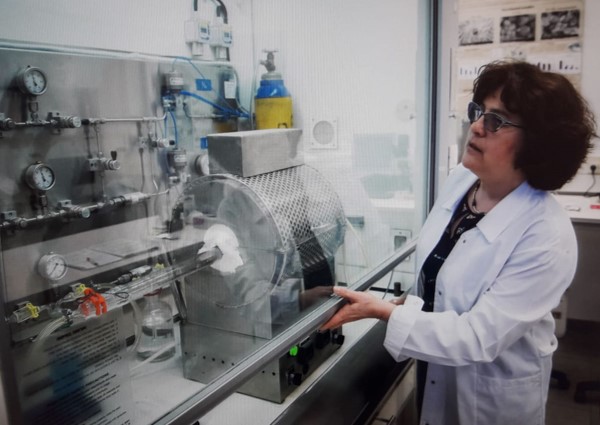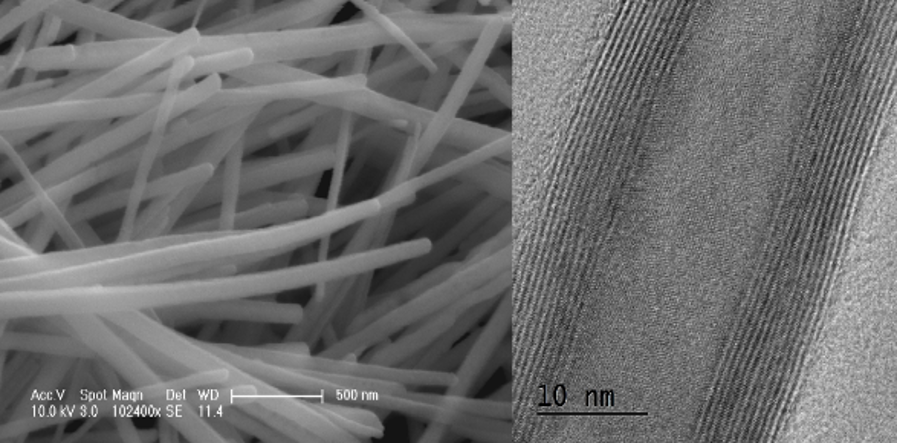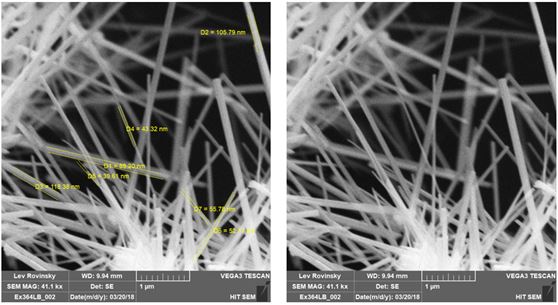More:
News & Stories
Two for Two: World Demand for Two Unique Nanotubes Synthesized in HIT Lab
Prof. Alla Zak's laboratory at HIT is the only one in the world to develop and synthesize the multipurpose nanotubes of WS2 and MoS2, now in great demand by researchers all over the world.
Thanks to their many unique properties the novel nanotubes have numerous applications – from medical devices to green energy, and from the automotive and defense industries to innovative batteries and transistors.

Innovative sensors, high-efficiency solar cells, improved hydrogen cells, industrial lubricants, medical protheses, bullet-proof vests, advanced batteries and transistors – these are just a few of the numerous existing and potential applications of two novel nanomaterials – nanotubes of WS2 (Tungsten disulfide) and MoS2 (Molybdenum disulfide), now originating from one groundbreaking lab at HIT's Faculty of Science.
"We are the only laboratory in the world currently synthesizing these two important nanomaterials in pure phase and significant amounts, supplying them to academic and industrial researchers all over the world," says Prof. Alla Zak, who heads the Nanomaterial Synthesis and Research Laboratory at HIT. "We have been synthesizing WS2 nanotubes for over a decade, and last year, following an intense five-year effort, we finally discovered the complex multistep process for producing MoS2 nanotubes as well [published in ACS Nano, Feb. 2020]. In this we solved an enigma that had been addressed unsuccessfully by researchers worldwide for almost 25 years." Both nanomaterials are synthesized at very high temperatures of 500-900 °C, in unique heat-resistant quartz reactors specially developed by Prof. Zak and her team.

"These nanotubes are truly amazing," says Prof. Zak. "They have a mindboggling variety of unique and useful properties – optical, mechanical, electronic and electro-mechanical (piezoelectric), catalytic, semiconducting, thermal… and the list goes on. Used on their own or added to other materials, WS2/MoS2 nanotubes can enable and/or significantly improve functions in numerous areas and industries (as noted above). So it's no wonder that they arouse considerable interest and are in high demand by many different sectors."
As the exclusive source of high-quality WS2 and MoS2 nanotubes, the HIT laboratory collaborates with researchers across the globe - from Japan, China and India, through Europe to North America – who wish to further investigate these important nanomaterials and their properties, and/or use them to develop innovative applications. Each lab has its own interests and the advanced equipment needed for their specific field, and the team at HIT is able to prepare nanotubes with a variety of characteristics as per concrete scientific tasks. In this way our team learns more and more about the materials they synthesize – through what Prof. Zak describes as "highly beneficial win-win collaborations."

According to Prof. Zak, her lab is presently working closely with 8 different research centers in Israel and overseas, and just in the last 13 months (February 2020 – March 2021), these collaborations have engendered no less than 10 scientific papers in important international publications (including the breakthrough paper in ACS Nano, mentioned above). While some of these deal with basic science (like one published in March 2021 in The Journal of Physical Chemistry C), others describe a range of innovative applications in various fields. Following are five illuminating examples:
One study, carried out with researchers in Italy and published in the Small journal, found that WS2 nanotubes can serve as highly effective piezoresistive strain sensors – gauges that modify their electrical resistance or generate an electrical current in response to mechanical deformation - stretching or shrinking), or alternately, change their shape when an electrical field is applied. Today such sensors are commonly found in touch screens and digital watches. Prof. Zak notes: "These piezoelectric properties are found only in the tiny nanotubes, and not in the larger-scale macro-crystals of WS2 and MoS2 – an excellent example of the importance of nanotechnology."
Another project, conducted in collaboration with Rafael Advanced Defense Systems in Israel and published in Composites Science and Technology, showed that adding just a small amount of WS2 nanotubes to the polymer methyl methacrylate (PMMA) generates a composite material with immensely improved mechanical properties - including a 31% enhancement of energy absorption capacity (toughness), 23% rise in impact strength, and 83% increase in strain at break. These impressive properties make the composite material an exceptional candidate for a range of advanced antiballistic applications – from bulletproof vests to lightweight armored vehicles.
A paper published in ACS Applied Energy Materials, together with researchers from Bangalore, India, discusses nanocomposites of MoS2 nanotubes with two other types of nanotubes (carbon and borocarbonitride) nanotubes, and their effectiveness as photocatalysts and electrocatalysts in chemical reactions producing hydrogen fuel – a fast-emerging form of clean energy, emitting only water molecules. Findings indicate that the addition of MoS2 nanotubes to the composite significantly enhances the electrocatalytic hydrogen evolution reaction (water-splitting process) doubling the yield of H2 (100% increase).
A collaboration with researchers in Germany, Spain and the Weizmann Institute generated a paper in Applied Physics Reviews, taking WS2 and MoS2 to the world of quantum physics. The study reveals that the nanotubes' unique quantum properties make them promising candidates for such applications as photocatalysts, as well as novel field effect transistors, photodetectors, switchable electronics and numerous optoelectronic applications.
A joint effort with labs in Sweden, India and the Weizmann Institute, published in Wiley Polymer Composites, showed that the addition of WS2 contributed to a hybrid composite that profoundly enhanced both the thermal and mechanical properties of the polymer polyvinyl alcohol (PVA) – a biocompatible polymer commonly used in medical applications such as cartilage replacements, contact lenses and eye drops, as well as photographic film and various other industrial and pharmaceutical applications. The hybrid composite showed remarkable improvement over neat PVA: tensile strength increased by 138%, elasticity (Young's modulus) enhanced by 142%, and toughness amplified 246%, as well as lower water uptake and better thermal stability.
"These findings and many others pave the way for the development of novel materials and nanomaterials with greatly enhanced properties and a plethora of advanced applications, based on the nanotubes and other nanomaterials developed and synthesized in our laboratory at HIT," concludes Prof. Zak "We fully intend to continue our research and generate more beneficial discoveries in the coming years."
Posted: 25/03/2021
- News & Events
New Collaboration with Sheba Medical Center will qualify nurses to work in a digital environment.
Collaboration between HIT Holon Institute of Technology, the teaching authority of the Sheba Medical Center, and the Sheba-BEYOND virtual hospital will allow training nurses in Israel and around the world to work in a digital...



 Additional programs
Additional programs
